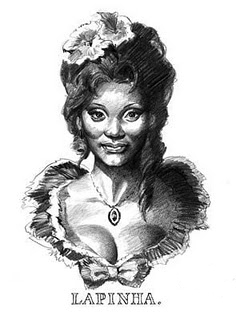By Stephen Brookes • The Washington Post • January 18, 2012
Never heard of Joaquina Lapinha? Don’t worry. She was an obscure Brazilian soprano who briefly lit up the concert halls of Lisbon in the early 19th century. The closest she came to immortality was when a passing Swede caught her act and wrote, with admirable Scandinavian reserve, that she had a “good voice.” But Lapinha had a bigger claim to fame: almost single-handedly, she introduced Europeans to the music of little-known Brazilian composers of the time. And in an intriguing — if trouble-prone — concert on Sunday at the National Gallery of Art, the musicologist Ricardo Bernardes, soprano Rosana Orsini and the early-music Americantiga ensemble resurrected much of Lapinha’s actual repertoire, shining a light into a forgotten corner of 19th century musical life and showing just how far Europe dominated the cultural life of its colonies.
But Lapinha had a bigger claim to fame: almost single-handedly, she introduced Europeans to the music of little-known Brazilian composers of the time. And in an intriguing — if trouble-prone — concert on Sunday at the National Gallery of Art, the musicologist Ricardo Bernardes, soprano Rosana Orsini and the early-music Americantiga ensemble resurrected much of Lapinha’s actual repertoire, shining a light into a forgotten corner of 19th century musical life and showing just how far Europe dominated the cultural life of its colonies.
There was nothing, in fact, noticeably “Latin” about any of the evening’s music. Two late 18th century works by Antonio Leal Moreira were wrought in “classical” European style — think ersatz Mozart and you have the idea — but were skillfully done with touches of real imagination and fire. Orsini herself proved to be an engaging interpreter. She has a light, agile voice that, though it tended to vanish in the low end and could get brittle in fast passages, suited the works perfectly, and stood out well against the soft-voiced period instruments of the Americantiga players.
But to Orsini’s evident chagrin, things began to fall apart during an aria from Valentino Fioravanti’s cantata “L’Imene trionfante.” Conducting from the harpsichord, Bernardes seemed to lose the plot for a minute, and — as Orsini and bassoon soloist Anna Marsh exchanged alarmed looks — the music nearly derailed before lurching back on track. That may have rattled the ensemble, for the players then got so tangled up in an aria from Jose Mauricio Nunes Garcia’s “Triunfo da America” that Bernardes was forced to completely stop the music and reboot.
Orsini — a drop-dead beauty who looks like she just stepped out of a Helmut Newton photograph — appeared ready to strangle the lot of them by that point, but came back strong in a dramatic aria from Bernardo de Souza Queiroz’s opera “Zaira.” It was a heartfelt performance and a fine climax to the concert — even if you did sense she was looking over her shoulder at Bernardes, steeling herself for the next disaster.